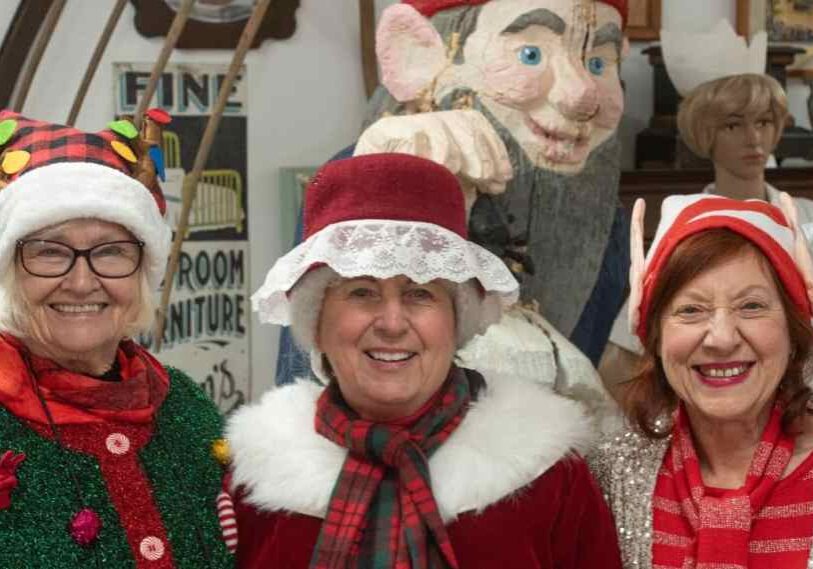Chiaroscuro — The Making of a Book
A group of friends creates a book of poetry by the late Peter Denzer

HOUSTON — To quote Peter Denzer, “in the beginning was the Word / but it was a sigh / the first of twelve tones.”
I did not have the chance to meet Peter before his death in 2012, but through his wife’s stories I know him to be a writer, sculptor, potter, activist, gardener, and a poet. He wrote hundreds of poems during his long life and his wife, Mary Denzer whom he affectionately called Maria, has finally completed an illustrated collection of his poems.
The book, Chiaroscuro, will be showcased as a part of the Laureates Writers Series at the Blue Heron Coffeehouse in Winona on Tuesday, May 7, at 7:00 p.m.
Light, darkness, Italy
Mary is a potter and an avid artist. In her early twenties, her interest in becoming an artist took her to Florence, Italy. It was on the Ponte Vecchio, while browsing wares made by local goldsmiths, where she first met Peter. This began their life together of living, working, and making art. I work with Mary as a pottery apprentice and I have learned more about art and life from Mary than I could ever have imagined. (You can read more about that story in John Torgrimson’s Root River Current article An Artisan and The Apprentice.)
Mary named this collection Chiaroscuro in reference to the term made famous by 17th century painter, Caravaggio. In visual art, the term represents the use of strong contrasts between light (chiaro in Italian) and dark (scuro in Italian).

The book cover for Chiaroscuro – Selected Poems. (Courtesy Shipwreckt Books)
For this book Mary adds, “It’s called Chiaroscuro because that’s the way Peter was. He was light and dark.”
Peter envisioned a book of poetry with linocut illustrations made by Mary, family, and friends. And through a grant from the Southeastern Minnesota Arts Council, Mary has made it a reality.
During his life, Peter worked closely with fellow poet, Emilio DeGrazia. A first-generation Italian-American, Emilio grew up in Detroit but found the Driftless Region when he began teaching English at Winona State University in the late 1960s. They met by chance at Art in the Park in Lanesboro when their two booths happened to be next to each other.
Quickly bonding over their shared Italian experiences, Peter and Emilio were like brothers and the Denzers and DeGrazias shared many exuberant dinner parties filled with pasta, wine, and smiling faces.
Adding order and artwork
Emilio was the perfect person to help Mary as she started assembling this collection. Through Emilio, Mary met Tom Driscoll, editor and publisher of Shipwreckt Books Publishing Company in Winona, MN. In addition to publishing and editing, Tom is a writer, poet, and former Peace Corps volunteer with spectacular stories about his time abroad.
After the four of us — Mary, Emilio, Tom, and myself — first met to discuss the book, we knew that together we could create something truly beautiful.
With Emilio as the copy editor, the selection and organization of the poems was the first mission. Emilio read through three thick binders of poems and even more he had on his computer from when he worked with Peter, rating each one on a scale of one to five. Then he created five chapters for 83 poems chosen for the final cut.
Emilio writes, “In this book you will find a collection of poems expressing Peter Denzer’s sense of chiaroscuro, a well-used Italian expression of the paradoxical unity of darkness and light — that darkness may clarify light’s deepest hues — perhaps so we may better learn how to live the good life together.” Mary Denzer and a team of friends’ created more than 100 illustrations for the book. (Photo Delia Bell)
Mary Denzer and a team of friends’ created more than 100 illustrations for the book. (Photo Delia Bell)
Back home in Houston County, Mary got to work on creating the artwork and set up a makeshift printing studio in her kitchen. She and I would choose a poem and draw a sketch to best illustrate what the poem is about, then we’d transfer the sketch to a block of soft linoleum which we’d meticulously carve to create a relief print.
After a batch of a dozen or so blocks were complete, it was time to print. We’d roll ink across each block, press a piece of paper onto the ink-coated block and peel it away to reveal the carved design. All of the prints are simple black ink on white paper, further communicating the light and dark theme of the book.
Art meets life
Everything was moving along until Halloween Day in 2023 when Mary experienced a “darkness” of her own. While shoveling the path to her house, her cleats stuck in a crack and she fell fracturing her femur which required surgery. Then a month later, she and I both tested positive for Covid-19. While recovering at home, she once again snapped her femur, this time requiring a much more serious second surgery and recuperation in Houston at Valley View Health Care.
Not one to give up, I brought Mary her carving tools and some blocks so that she could keep working on prints in between her daily physical therapy sessions. She was also graciously given an extension on her capstone date which was originally planned for March 2024. Through it all, Mary maintained her sense of joy and purpose for life and this project and can finally now share it with the world.


A Lino print for the poem Speaking in Tongues.
The book includes 110 total illustrations. In addition to the prints that Mary and I made, we have illustrations by Kiko Denzer, Isaac Denzer, Jacque Parker, Eben Denzer, Linda Griggs, John B. Nicol, Tom Driscoll, Peter W. Denzer, Anna Loney, April Royet, J.B. and Susan Denzer, Billy X. Curmano, Hannah Field, Amanda Griggs, and Steven Denzer. And we’re all excited to present Chiaroscuro to the community on Tuesday, May 7, at 7:00 p.m. as a part of the Laureates Writers Series at the Blue Heron Coffeehouse, 162 W 2nd Street in Winona, MN.

Root River Current’s coverage of the arts is made possible, in part, by the voters of Minnesota through a grant from the Southeastern Minnesota Arts Council thanks to a legislative appropriation from the arts & cultural heritage fund.






